ARCHIVED: Chapter 1. Introduction To Pavement Recycling
| << Previous | Contents | Next >> |
Recycling or reuse of pavement material is a very simple but powerful concept. Recycling of existing pavement materials to produce new pavement materials results in considerable savings of material, money, and energy. At the same time, recycling of existing material also helps to solve disposal problems. Because of the reuse of existing material, pavement geometrics and thickness can also be maintained during construction. In some cases, traffic disruption is less than that for other rehabilitation techniques. The specific benefits of recycling can be summarized as follows:
- Reduced costs of construction.
- Conservation of aggregate and binders.
- Preservation of the existing pavement geometrics.
- Preservation of the environment.
- Conservation of energy.
- Less user delay.
Recycling As A Rehabilitation Alternative
Several studies(1,2) have shown that it costs highway agencies less if the pavements are kept at a certain acceptable level of serviceability. According to World Bank Sources(2), each $1.00 spent during the first 40 percent drop in quality will cost $4.00 to $5.00 if delayed until the pavement loses 80 percent of its original quality (figure 1-1). Rehabilitation is needed to maintain the pavement at a certain condition. Rehabilitation of pavement is also needed due to the following reasons:
- Inadequate ride quality.
- Excessive pavement distress.
- Reduced surface friction.
- Excessive maintenance requirement.
- Unacceptable user costs.
- Inadequate structural capacity for planned use or projected traffic.
Figure 1-1. Plot of pavement condition versus time.(2)
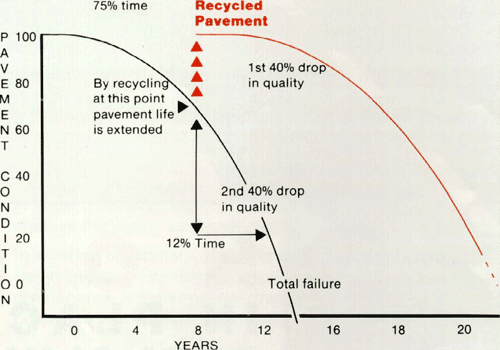
Recycling is only one of the several rehabilitation alternatives available for asphalt pavements.(3) Some of the other common methods are thick or thin hot mix asphalt (HMA) overlay. The choice of rehabilitation alternative depends on observed pavement distress, laboratory and field evaluation of existing material, and design parameters.(4) Also, maintenance of geometrics and original thickness of pavements, especially in underpasses, influence the choice of rehabilitation method. However, recycling has some unique advantages which are not available with other types of rehabilitation techniques. For example, recycling can result in savings, help in conservation of natural resources, and can maintain pavement geometrics as well as thickness. Different recycling methods are now available to address specific pavement distress and structural needs.
Recycling Methods And Processes
The Asphalt Recycling and Reclaiming Association(5) defines four different types of recycling methods: (1) hot recycling; (2) hot in-place recycling; (3) cold in-place recycling; and (4) full depth reclamation.
- Hot mix asphalt recycling is the process in which reclaimed asphalt pavement (RAP) materials are combined with new materials, sometimes along with a recycling agent, to produce hot mix asphalt (HMA) mixtures. Both batch and drum type hot mix plants are used to produce recycled mix. The RAP material can be obtained by milling or ripping and crushing operation. The mix placement and compaction equipment and procedures are the same as for regular HMA.
Typically, 10 to 30 percent RAP is used in recycled hot mixes. Figure 1-2 shows introduction of RAP material in a drum plant. The advantages of hot mix recycling include equal or better performance compared to conventional HMA, and capability to correct most surface defects, deformation, and cracking.
Figure 1-2. Introduction of RAP material in a drum plant.
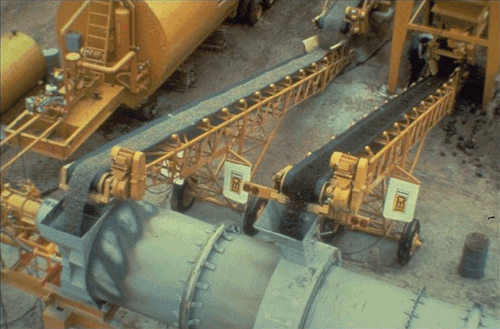
- Hot in-place recycling (HIR) consists of a method in which the existing pavement is heated and softened, and then scarified/milled to a specified depth. New HMA (with/without RAP) and/or recycling agent may be added to the scarified RAP material during the recycling process. HIR can be performed either as a single pass or as a multiple pass operation. In single pass operation, the scarified in-place material can be combined with new material if needed or desired. In multiple pass operation, the restored RAP material is recompacted first, and a new wearing surface is applied later. The depth of treatment varies between 20 to 50 mm (¾ in to 2 in). The Asphalt Recycling and Reclaiming Association (ARRA) has identified three HIR processes; (a) surface recycling, (b) repaving, and (c) remixing. Figure 1-3 shows a surface recycling operation. This is a type of HIR operation in which the existing asphalt surface is heated and scarified to a specified depth. The scarified material is combined with aggregate and/or recycling agent. The mix is then compacted. A new overlay may or may not be placed in the recycled mix. In the second type of HIR method, repaving, the surface recycling method is combined with a simultaneous overlay of new hot mix asphalt (HMA). Figure 1-4 shows a HIR operation with the application of an overlay. Both the scarified mix and the new HMA are rolled at the same time. In the case of remixing (figure 1-5), the scarified RAP material is mixed with virgin HMA in a pugmill, and the recycled mix is laid down as a single mix. The advantages of hot in-place recycling are that surface cracks can be eliminated, ruts and shoves and bumps can be corrected, aged asphalt is rejuvenated, aggregate gradation and asphalt content can be modified, traffic interruption is minimal, and hauling costs are minimized.
Figure 1-3. Surface recycling.
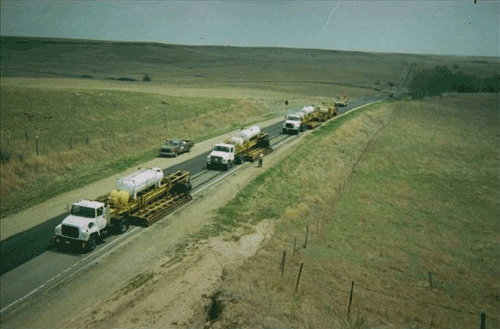
Figure 1-4. Hot in-place recycling operation with application of overlay (repaving).
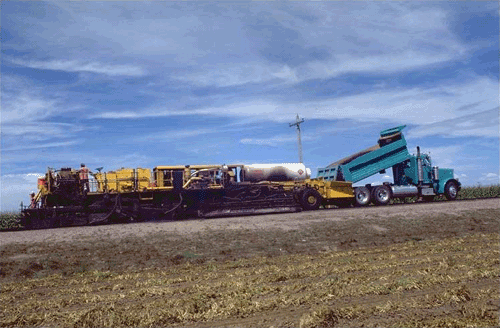
Figure 1-5. Remixing.
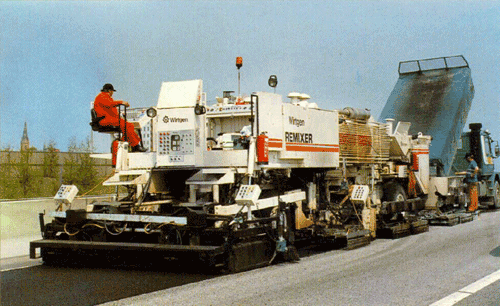
- Cold in-place recycling (CIR) involves reuse of the existing pavement material without the application of heat. Except for any recycling agent, no transportation of materials is usually required, and aggregate can be added, therefore hauling cost is very low. Normally, an asphalt emulsion is added as a recycling agent or binder. The emulsion is proportioned as a percentage by weight of the RAP. Fly ash or cement or quicklime may also be added. These additives are effective for over asphalted and low stability mixes. The process includes pulverizing the existing pavement, sizing of the RAP, application of recycling agent, placement, and compaction. The use of a recycling train, which consists of pulverizing, screening, crushing and mixing units, is quite common. The processed material is deposited in a windrow from the mixing device, where it is picked up, placed, and compacted with conventional hot mix asphalt laydown and rolling equipment. The depth of treatment is typically from 75 to 100 mm (3 to 4 in). The advantages of cold in-place recycling include significant structural treatment of most pavement distress, improvement of ride quality, minimum hauling and air quality problems, and capability of pavement widening. Figure 1-6 shows a typical CIR operation with a milling machine, a crusher and screening plant, and a mix-paver.
Figure 1-6. Cold in-place recycling.
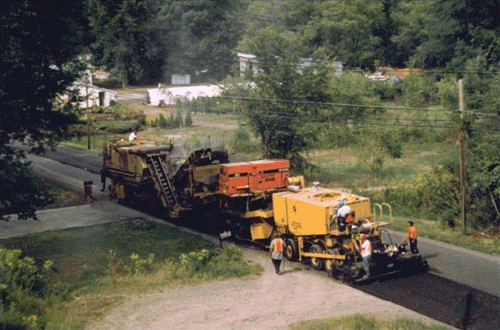
- Full depth reclamation (FDR) has been defined as a recycling method where all of the asphalt pavement section and a predetermined amount of underlying base material is treated to produce a stabilized base course. It is basically a cold mix recycling process in which different types of additives such as asphalt emulsions and chemical agents such as calcium chloride, portland cement, fly ash, and lime, are added to obtain an improved base. The four main steps in this process are pulverization, introduction of additive, compaction, and application of a surface or a wearing course. If the in-place material is not sufficient to provide the desired depth of the treated base, new materials may be imported and included in the processing. New aggregates can also be added to the in-place material to obtain a particular gradation of material. This method of recycling is normally performed to a depth of 100 mm to 300 mm (4 to 12 in).(6) Figure 1-7 shows a full depth reclamation train in action. The train consists of recycling machine hooked to a water tanker and steel drum roller with pad foot shell. The advantages of full depth reclamation are that most pavement distresses are treated, hauling costs are minimized, significant structural improvements can be made (especially in base), material disposal problems are eliminated, and ride quality is improved.
Figure 1-7. Full depth reclamation.
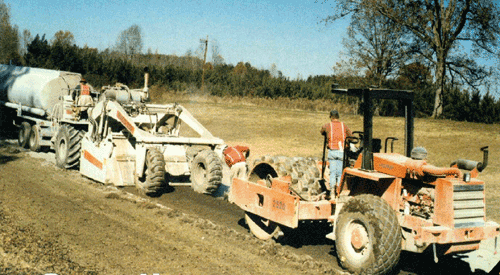
Pavement Distress
The majority of pavement distress can be categorized as surface distress or deformation or cracks, or a combination of these three. Surface distress, such as raveling (figure 1-8) or bleeding (figure 1-9) or aggregate polishing (figure 1-10) can be treated with either hot mix or hot in-place recycling. Deformation in the form of corrugation (figure 1-11) can be treated with hot mix or hot in-place recycling, whereas rutting (figure 1-12) can be treated with hot or cold in-place recycling or full depth reclamation, depending on the location of the problem in the pavement structure. Pavements with cracks such as those caused by shrinkage from low temperatures (figure 1-13) and/or hardening of asphalt can be rehabilitated with cold in-place recycling or full depth reclamation. Depending on the severity and extent of distress, a variety of recycling options is available for rehabilitation of deteriorated pavements. The selection of a specific type of recycling method depends on engineering considerations, such as distress, structural strength, availability of equipment, availability of experienced contractors, cost and construction impact on traffic. These considerations are discussed in detail in chapter 3.
Figure 1-8. Raveling.
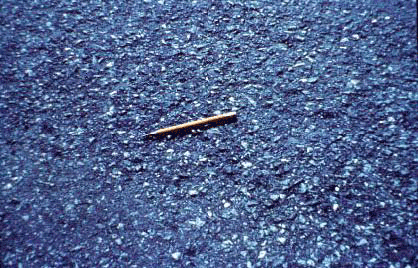
Figure 1-9. Bleeding.
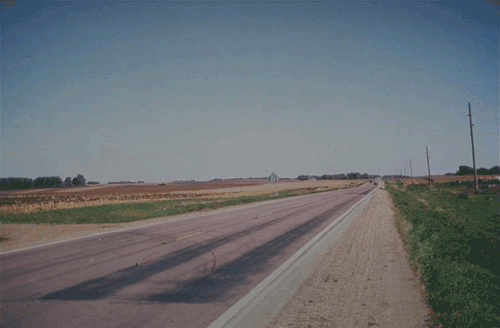
Figure 1-10. Aggregate polishing.
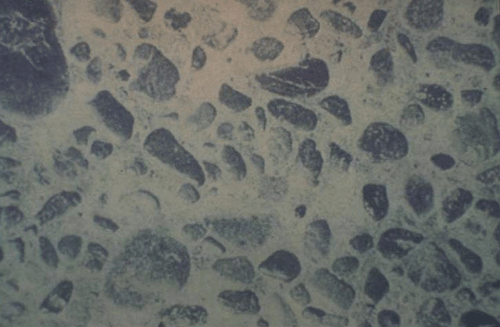
Figure 1-11. Corrugation.
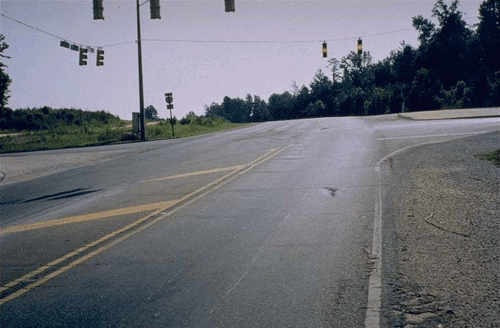
Figure 1-12. Rutting.
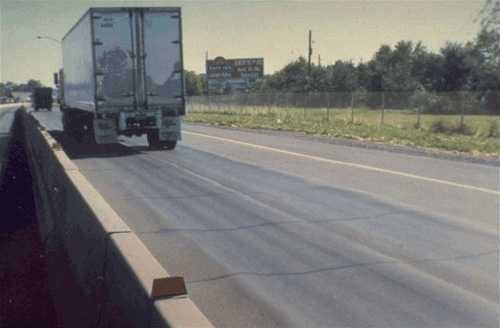
Figure 1-13. Transverse cracks.
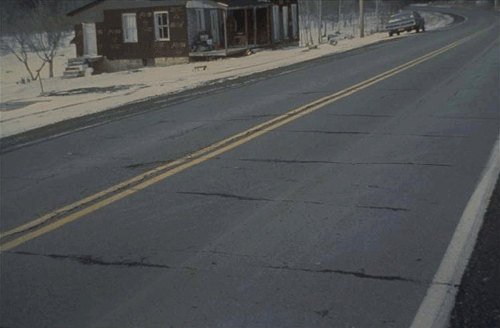
Summary
Recycling is one of the several alternatives available for rehabilitation of pavements. Other methods include overlay and complete removal and replacement. Recycling is increasingly being used because of the following advantages: (a) reduced cost of construction, (b) conservation of aggregate and binders, (c) preservation of existing pavement geometrics, (d) preservation of environment, and (e) conservation of energy. Different recycling techniques are available to address specific pavement distress and/or pavement structural requirements. The four primary recycling methods most commonly used are hot mix recycling, hot in-place recycling, cold in-place recycling, and full depth reclamation. The choice of a particular technique depends on engineering considerations (such as pavement distress and structural strength), availability of necessary equipment, availability of experienced contractor, initial cost, construction impact on traffic, and long term maintenance costs.
References
- D.E. Peterson. Good Roads Cost Less (Pavement Rehabilitation Needs, Benefits, and Costs in Utah), Report No. UDOT-MR-77-8, Utah DOT, Salt Lake, UT, 1977.
- Asphalt Recycling and Reclaiming Association. Hot In-Place Recycling, Presented by the Hot In-Place Recycling Technical Committee, ARRA Convention, 1996.
- J.A. Epps, D.N. Little, R.J. Holmgreen, and R.L. Terrel. Guidelines for Recycling Pavement Materials, NCHRP Report 224, TRB. National Research Council, Washington, DC, 1980.
- J.A. Epps, R.L. Terrel, and D.N. Little. "Recycling Pavement Materials," Rural and Urban Roads, May 1978.
- An Overview of Recycling and Reclamation Methods for Asphalt Pavement Rehabilitation. Asphalt Recycling and Reclaiming Association, Annapolis, MD, 1992.
- J.A. Epps. Cold-Recycled Bituminous Concrete Using Bituminous Materials, NCHRP Synthesis of Highway Practice 160. TRB, National Research Council, Washington, DC, 1990.
| << Previous | Contents | Next >> |

